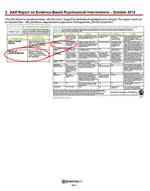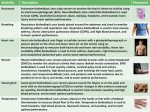Biofeedback/Neurofeedback
What is Biofeedback?
Bio = body & Feedback = information given back to you
Our bodies have ways of telling us things. Our stomach growls when hungry, our body temperature rises if there is an infection, we experience pain as a mechanism of alarm that there is body injury that requires repair. Our bodies can tell us a lot if we are aware and are listening. Biofeedback is a method of applying sensors on the body in order to monitor respiration, temperature, skin conductance, heart rate variability and muscle tension. These are key aspects related to our Autonomic Nervous System. They help us to have a greater understanding of the dynamic relationship between our “stress” or “arousal” response (sympathetic) and our “rest and digest” response (parasympathetic).
If a roaring lion comes charging in the room, our automatic response would be to scream and run from danger. That is when our ANS sympathetic system identifies and alerts us of danger and prepares the body to run by increasing heart rate, respiration, and we feel cold and clammy. When resting on a lounge chair reading a good book, our heart rate and respiration are slow and steady and our hands warm and dry as a result of the parasympathetic system.
Biofeedback is a useful tool to train individuals to understand the role of their autonomic nervous system and understand their own body signals so they can be equipped to take an active role in self-regulation to diminish troublesome symptoms that hinder their success and productivity in life. Training sessions are usually once per week.
Those who would benefit most from biofeedback would be those who experience:
- Stress
- Anxiety
- High blood pressure
- Headaches
- Chronic pain
- TMJ
- Raynaud’s phenomenon
- Poor circulation related to Diabetes
- Post-traumatic stress
Association for Applied Psychophysiology and Biofeedback
AAPB website: www.aapb.org
What is Neurofeedback?
Neuro = brain & Feedback = information given back to you

Neurofeedback is also called EEG biofeedback or brain wave training. It is a type of biofeedback that can train individuals to improve their brain function. Brain rhythms are regulated through the Central Nervous System. Small sensors are applied with conductive paste to the scalp to record the brain activity at a specific site. The computer collects and analyses the data and gives a visual feedback of information in real time. Through a process called operant conditioning, the brain can be rewarded with visual displays or auditory tones in order to guide it to move in a new direction that will lead to improved success in life and learning. This type of feedback enables an individual to learn to regulate their own brain states more efficiently.
The American Psychological Association endorses biofeedback as an evidence based intervention. The American Academy of Pediatrics endorses biofeedback as evidence based Level 1 support for Attention Deficit Disorder. Continued research shows promising effectiveness of neurofeedback for:
- Anxiety
- Autism
- Conduct Disorder
- Depression
- Developmental Disorders
- Epilepsy
- Insomnia
- Learning Disorders
- Sensory Processing Disorder
- Substance Abuse
- Traumatic Brain Injury
Neurofeedback is used by professional athletes and performers to enhance peak performance with improved concentration and memory, enhanced creativity, ability to problem solve and reduction in performance anxiety. College students and elderly adults benefit from neurofeedback with improved attention, processing speed and executive function.
Training is usually twice per week for a period of 20 – 40 sessions or more depending on the individual’s age, cognitive receptivity to training and the severity of the condition.
A brain map is strongly advised to identify any specific brain regions that are disregulated and a personalized neurofeedback protocol can be developed to be the most precise for that individual.
Training sessions are about 20 – 30 minutes of feedback within a 50 minute session.
Neurofeedback is non-invasive, does not involve medication, is not painful and has lasting effects.
International Society for Neurofeedback and Research
ISNR website: www.isnr.org

